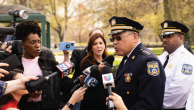Virginia Tech Shooting Tops Year
On the morning of Monday April 16, a deeply disturbed Virginia Tech student went on a shooting rampage on campus that claimed 33 lives, including his own. By the end of that wrenching week, some member of the student body exhausted by both the trauma and the press attention, composed this sign on the school’s drill field: “VT stay strong. Media stay away.”
In those few days, the Virginia Tech massacre became the most covered single story in any week so far this year. More than half of all coverage (51%) from April 15-20 was devoted to the massacre.
That put the shooting at the Virginia campus far ahead of any other story for such concentrated coverage this year.
The next most intensely covered story in any given week was the Iraq policy debate from Jan. 7-12, the week that President Bush announced his controversial “surge” policy. The story filled 34% of the newshole in the PEJ Index.
Next, or the third most heavily covered event of the year, was the firing of talk host Don Imus after he made crude remarks about the Rutgers women’s basketball team. During that week, April 8-13, the Imus saga accounted for 26% of all the coverage.
Nothing else this year filled even one fifth of the newshole in any given week. The next two most intensely covered stories in the first six months related to the ongoing probe of the U.S. Justice Department and Attorney General Alberto Gonzales following the firing of eight U.S. attorneys for what some suspected were political reasons.
During the week of March 18-23, when Congress authorized subpoenas of top Bush adviser Karl Rove and former White House Counsel Harriet Miers, that Justice Department scandal filled 18% of the newshole. From March 11-16, that subject filled 16% of the newshole in a week in which Gonzales admitted to mistakes in handling the issue and embarked on a media tour to help save his job.
Attention Deficit?
For all that Virginia Tech stands out as the most heavily covered event of the first six months of 2007, however, in the end the media didn’t stay on the story very long.
During that time frame the narrative followed a fairly well-defined arc, turning from the actual shooting to trying to make sense of the enigmatic, uncommunicative killer, Seung-Hui Cho (which also involved a chilling and controversial manifesto from him), and then to Virginia Tech community efforts to heal.
The media also turned to longer-term issues including the questions of student privacy and mental health and the highly political issue of gun control. Talk hosts in particularly, quickly took up sides on this issue. Conservatives like Sean Hannity argued that guns are more frequently used for protection than harm: “The fallacy here is that guns are the problem. It’s not. It’s the evil intention in the heart of somebody that does not respect a human life.”
But none of the issues raised by the incident inspired any sustained national dialogue in the media, be it the ability of the mental health system to track disturbed patients, the public safety communications systems that made it impossible to alert students, or more.
Only one week after accounting for half the nation’s news coverage (April 22-27), the story nosedived down to 7%. By the week of April 29-May 4, the story had virtually disappeared from the news, generating less than 1% of the total coverage. It never again reached more than 1% of the newshole in any week in the second quarter.



